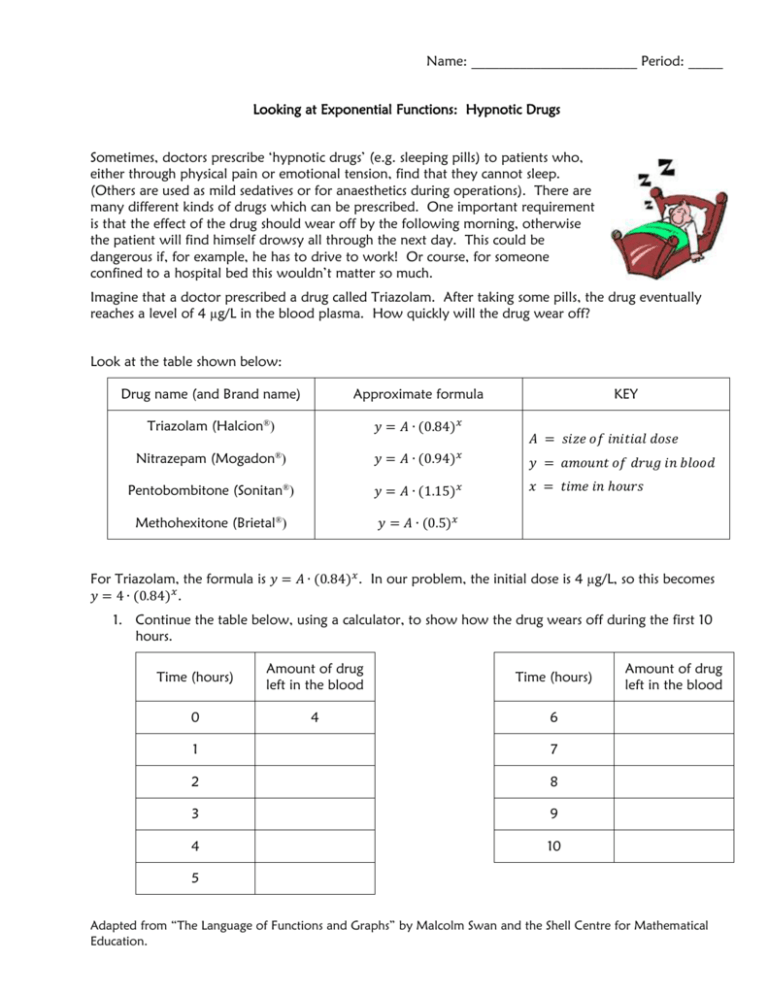Looking at Exponential Functions: Hypnotic Drugs
advertisement

Name: ________________________ Period: _____ Looking at Exponential Functions: Hypnotic Drugs Sometimes, doctors prescribe ‘hypnotic drugs’ (e.g. sleeping pills) to patients who, either through physical pain or emotional tension, find that they cannot sleep. (Others are used as mild sedatives or for anaesthetics during operations). There are many different kinds of drugs which can be prescribed. One important requirement is that the effect of the drug should wear off by the following morning, otherwise the patient will find himself drowsy all through the next day. This could be dangerous if, for example, he has to drive to work! Or course, for someone confined to a hospital bed this wouldn’t matter so much. Imagine that a doctor prescribed a drug called Triazolam. After taking some pills, the drug eventually reaches a level of 4 µg/L in the blood plasma. How quickly will the drug wear off? Look at the table shown below: Drug name (and Brand name) Approximate formula Triazolam (Halcion®) 𝑦 = 𝐴 ∙ (0.84)𝑥 Nitrazepam (Mogadon ) 𝑦 = 𝐴 ∙ (0.94) Pentobombitone (Sonitan®) 𝑦 = 𝐴 ∙ (1.15)𝑥 Methohexitone (Brietal®) 𝑦 = 𝐴 ∙ (0.5)𝑥 ® 𝑥 KEY 𝐴 = 𝑠𝑖𝑧𝑒 𝑜𝑓 𝑖𝑛𝑖𝑡𝑖𝑎𝑙 𝑑𝑜𝑠𝑒 𝑦 = 𝑎𝑚𝑜𝑢𝑛𝑡 𝑜𝑓 𝑑𝑟𝑢𝑔 𝑖𝑛 𝑏𝑙𝑜𝑜𝑑 𝑥 = 𝑡𝑖𝑚𝑒 𝑖𝑛 ℎ𝑜𝑢𝑟𝑠 For Triazolam, the formula is 𝑦 = 𝐴 ∙ (0.84)𝑥 . In our problem, the initial dose is 4 µg/L, so this becomes 𝑦 = 4 ∙ (0.84)𝑥 . 1. Continue the table below, using a calculator, to show how the drug wears off during the first 10 hours. Time (hours) Amount of drug left in the blood Time (hours) 0 4 6 1 7 2 8 3 9 4 10 Amount of drug left in the blood 5 Adapted from “The Language of Functions and Graphs” by Malcolm Swan and the Shell Centre for Mathematical Education. 2. Which of the following graphs best describes your data? Explain how you can tell without plotting. 3. Below, sketch 4 graphs to compare how a 4 µg dose of each the drugs will wear off. Guess the graphs – do not draw them accurately. 4. Only three of the drugs are real. The other was intended as a joke! Which is it? Explain how you can tell. What would happen if you took this drug? 5. Check your four graphs in question #3 by using a graphing calculator (or an online graphing tool). How do your graphs compare with the actual graphs? 6. Choose one of the four drugs to make a small letter-size poster. Your poster must have an accurate graph to show how the effect of the drug wears off, plus answers to the following: a. After how many hours has the amount of the drug in the blood halved? b. How does the “half life” depend on the size of the initial dose? c. Write down and explain all your findings. Adapted from “The Language of Functions and Graphs” by Malcolm Swan and the Shell Centre for Mathematical Education.






